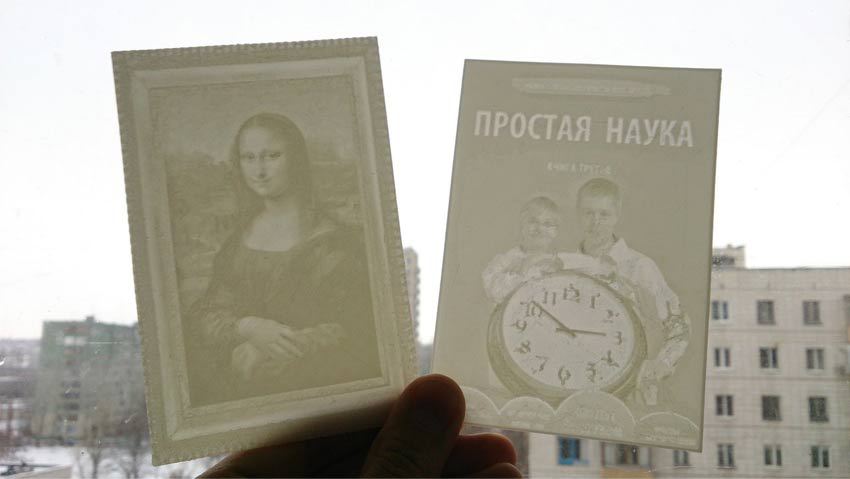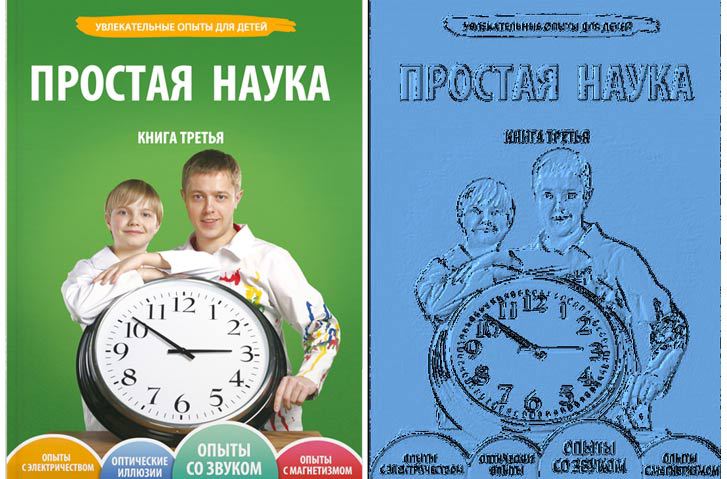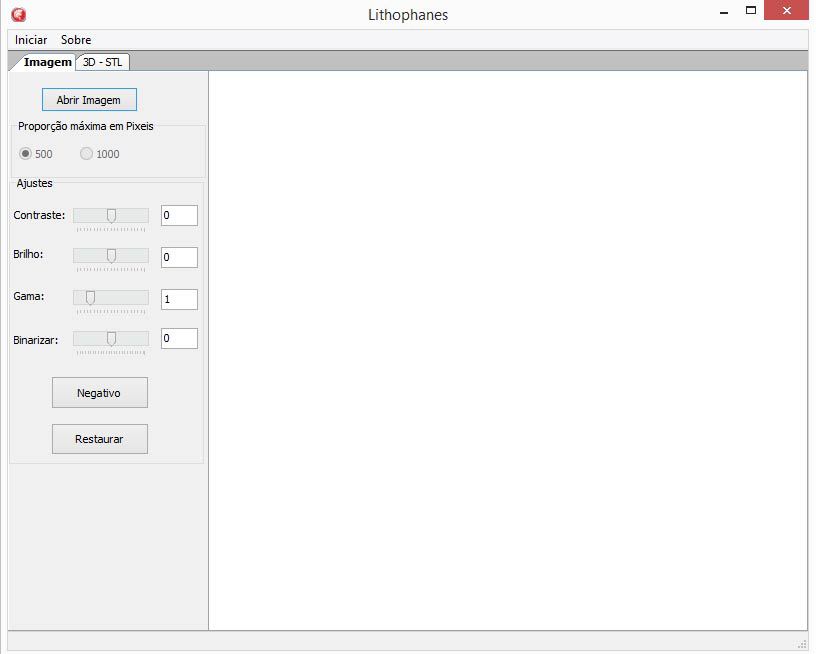Five things you can print on a 3D printer. Part number 3: the first book printed on a 3D printer?
We continue our cycle of publications, in which the owners of 3D printers tell and show that interesting things can be printed on these gadgets. Today, we will, so to speak, reinvent the printing press and photograph. Of course, we don’t pretend to be Laurels of Gutenberg and Niepce, but we can easily print the famous Gioconda or our wonderful book for children “ Simple Science ” on a printer. It remains only to add that the author of this manual is a student from Volgograd, Mikhail Kozenko, who, according to drawings from the Internet, created his own 3D printer, Volgobot.

')
Name and surname of the author of the project: Mikhail Kozenko
Printer model name: VolgoBot (own assembly)
Software: Lithophanes
Printer cost: 33 thousand rubles
Approximate weight: 8 kg
Approximate dimensions: 480x520x480
The main advantages of the printer according to the author:
The main disadvantages:
The amount of time spent on printing: 5 hours
The amount of material spent: 20 grams
Material financial costs: 30 rubles
Mikhail Kozenko is a student from Volgograd, about whom we have already written . He became famous for having assembled (precisely what he had assembled, and not invented) his own 3D printer, gradually improving every detail of the mechanism. Today, in the literal sense, several leading technical universities of Russia are fighting for it, inviting them to their conferences as an expert. His life has changed dramatically in just a few months. And I paint all this with one goal: we all have the same chance of success, and the only thing that can interfere is ourselves.
On his 3D printer, Misha prints not only key rings and souvenirs for classmates, but also more useful things. For example, reproductions of paintings, photographs and even books. For example, “ Simple Science ” is one of the first books in Russia printed on a 3D printer.
Typically, 3D printers using FDM technology (Fused Deposition Modeling, fusing method) allow you to print monochrome models. But you can create real photos / pictures or even book covers on them! To do this, you need to prepare a special 3D model (this can be done in many 3D editors). For example, for those people who do not have special skills to work with such programs, there is a free and quite comfortable Lithophanes . It has a simple interface, so mastering will not take more than 5-10 minutes. The program creates an STL file , which then only needs to be printed.
Not so long ago, I found on thingiverse.com and printed a black and white image of Gioconda on my 3D printer. Many acquaintances asked them to do something similar, but with their images. Most often - drawings, paintings and, of course, photographs.

Therefore, I had to learn to make such models. The book “Simple Science” was a guinea pig, or rather, the third volume of the series! Compare the “original” with a 3D layout ready for printing:

The method is simple as all ingenious. On the Internet, you can easily find and download the program Lithophanes , I got the Anglo-Spanish version.
Here is what the program interface looks like:



Further it is still easier: select the desired image and open it in the program:


We even have the opportunity to choose the “proportion” of our final image:

After the manipulations, we create the negative of this image (I remind you that the printer is printing in one color). Then go to 3D mode.

The generated file should look something like the one shown below. Do not forget about the size and layers and save the file in the .STL format.

I drove the resulting file through NetFabb , fixed the error with the frame of our lithography and sent it to print! Nothing is easier and you can not think! And the result will delight and warm - especially those who do not have a 3D printer at home and for whom this technology is something far away. In short, for my classmates a similar souvenir is the most it. +10 to popularity and +20 to attention from classmates.
Approximately the same principle of creating a model is used in wood lithography, but CNC machines are used there, which is much more serious than our home “animals”.
It turns out that such a plate with a shapeless relief looks like a black and white photo.

Next to the photograph is a printed and original book. In order to save material scale reduced. It turned out to keep within 20 grams, which in money transfer means 30 rubles.


')
Name and surname of the author of the project: Mikhail Kozenko
Printer model name: VolgoBot (own assembly)
Software: Lithophanes
Printer cost: 33 thousand rubles
Approximate weight: 8 kg
Approximate dimensions: 480x520x480
The main advantages of the printer according to the author:
- the printer is very flexible and easy to use.
- despite the fact that its assembly cost only 33 thousand rubles, it is able to produce print quality, as in more expensive printers.
The main disadvantages:
- the printer is self-made, and some moments have not been thought out yet, so you have to redo it.
The amount of time spent on printing: 5 hours
The amount of material spent: 20 grams
Material financial costs: 30 rubles
Mikhail Kozenko is a student from Volgograd, about whom we have already written . He became famous for having assembled (precisely what he had assembled, and not invented) his own 3D printer, gradually improving every detail of the mechanism. Today, in the literal sense, several leading technical universities of Russia are fighting for it, inviting them to their conferences as an expert. His life has changed dramatically in just a few months. And I paint all this with one goal: we all have the same chance of success, and the only thing that can interfere is ourselves.
On his 3D printer, Misha prints not only key rings and souvenirs for classmates, but also more useful things. For example, reproductions of paintings, photographs and even books. For example, “ Simple Science ” is one of the first books in Russia printed on a 3D printer.
Typically, 3D printers using FDM technology (Fused Deposition Modeling, fusing method) allow you to print monochrome models. But you can create real photos / pictures or even book covers on them! To do this, you need to prepare a special 3D model (this can be done in many 3D editors). For example, for those people who do not have special skills to work with such programs, there is a free and quite comfortable Lithophanes . It has a simple interface, so mastering will not take more than 5-10 minutes. The program creates an STL file , which then only needs to be printed.
Not so long ago, I found on thingiverse.com and printed a black and white image of Gioconda on my 3D printer. Many acquaintances asked them to do something similar, but with their images. Most often - drawings, paintings and, of course, photographs.

Therefore, I had to learn to make such models. The book “Simple Science” was a guinea pig, or rather, the third volume of the series! Compare the “original” with a 3D layout ready for printing:

The method is simple as all ingenious. On the Internet, you can easily find and download the program Lithophanes , I got the Anglo-Spanish version.
Here is what the program interface looks like:



Further it is still easier: select the desired image and open it in the program:


We even have the opportunity to choose the “proportion” of our final image:

After the manipulations, we create the negative of this image (I remind you that the printer is printing in one color). Then go to 3D mode.

The generated file should look something like the one shown below. Do not forget about the size and layers and save the file in the .STL format.

I drove the resulting file through NetFabb , fixed the error with the frame of our lithography and sent it to print! Nothing is easier and you can not think! And the result will delight and warm - especially those who do not have a 3D printer at home and for whom this technology is something far away. In short, for my classmates a similar souvenir is the most it. +10 to popularity and +20 to attention from classmates.
Approximately the same principle of creating a model is used in wood lithography, but CNC machines are used there, which is much more serious than our home “animals”.
It turns out that such a plate with a shapeless relief looks like a black and white photo.

Next to the photograph is a printed and original book. In order to save material scale reduced. It turned out to keep within 20 grams, which in money transfer means 30 rubles.

Source: https://habr.com/ru/post/366723/
All Articles